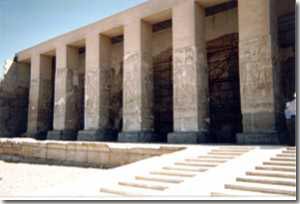| |
||||||
|
||||||
 |
|
|||||
The main temple (above) was built by the New Kingdom Pharaoh Seti I (1394-1279 BC), who came to power 29 years after the iconoclast Pharaoh Akhenaten, who outlawed the old religion and instituted a monotheistic cult of the sun god Aten. Wishing to make a gesture of reconciliation towards the ancient gods and their priests, Seti built a temple dedicated to Osiris, Isis, Horus, Amun, Mut and Khensu, as well as himself. This beautiful and elaborately adorned temple is in remarkably good
condition. Many of the wall paintings still possess their original color.
The temple has a 'King's Gallery' with walls engraved, not only with
the names of the gods, but with all the previous dynasties and royal
pharaonic predecessors of Seti - an invaluable resource for historians. |
||||||
Outside the main temple is the Osirieon, the tomb of Seti himself, which was built before the main temple to express the closeness of Seti to Osiris. The structure, partly buried due to flooding, is composed of red Aswan granite pillars, each weighing about a hundred tons, which support equally impressive marble archways. Curiously, Seti himself is not buried here. His tomb lies in the Valley of the Kings. The Abydos tomb, while fully equipped and furnished, seems never to have received the mummy of the king. Apparently it served an entirely symbolic and religious, not practical, function. This was apparently common practice, as kings and rulers sought favour with Osiris, but still chose to be buried elsewhere, for whatever reasons. These so-called 'false' or empty tombs and cenotaphs can be found all over Egypt, but Abydos contains an unusual concentration of them. |
|
|||||
|
||||||
Home | Nile Valley | Dynasties | Wealth | Divinity | Temples | Hieroglyphs | Mysteries
|
||||||
